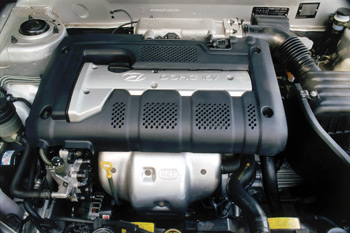This month, we’re going to take a look at the cooling system on the Hyundai line of vehicles. While the information is applicable to any Hyundai, including the Accent, Elantra and Sonata, it is also relevant to any of the cars that are in your bays.
Cooling system problems will present themselves in a variety of ways, and it’s important that your service writer has the skills to ask the correct questions that will help your techs make efficient repairs. Some are straightforward, but if the car is leaving puddles of coolant whenever it’s parked there isn’t much more you need to know. On the other hand, there are times when a seemingly unrelated complaint will turn out to be a cooling system issue that will be easy to identify, but the tech has to know where to look. The most common of these is a no- or intermittent-heat complaint.
FILLING PROCEDURE
The first step when dealing with any problem that involves the cooling system is to be sure the system is full and all the air is bled out. And a no-heat complaint isn’t any different in that respect: A common mistake for an inexperienced tech is to take a quick look at the coolant reservoir or overflow bottle and assume that if the level is good, then the system is full. But that may not be the case — you have to be sure to check the level in the pressurized system. If the reservoir isn’t low, but the radiator level is, it’s an indication that there is either a leak in the system or a bad radiator cap. Even a slight leak will prevent the system from making enough vacuum to pull coolant from the bottle. In a well-sealed system a bad cap will often result in a collapsed hose.
I mentioned bleeding the system, and I don’t think any experienced tech hasn’t struggled with a tough case of an air-locked cooling system. The good news is that a Hyundai doesn’t usually present a problem. If the system needs to be topped up with any amount of coolant, treat it as you would an initial fill. Attach the funnel to the fill point, getting the coolant higher than any part of the cooling system. Turn the heater control to hot and allow the engine to warm up. There are a few things we can learn as the car warms up. This is a good time to take a hard look at the system for any of that telltale staining that indicates coolant has been escaping. First, take a look at the radiator condition.
Keep in mind what the customer has reported; if the complaint is overheating and the correct questions were asked, you know the “when” and the “how.” If the car gets hot in a hurry and has boiled over, keep a close eye on the temp as the engine warms up, in the event that the thermostat is stuck closed; it won’t take long for the engine to reach temp with no flow to the radiator. An infrared temp gun is a big help when looking at the thermostat opening temp. Just take a look at engine-side temp versus the radiator side, and you can tell when and if the valve has opened. Another indication of flow will be the coolant movement in the filler funnel and temperature change when the thermostat opens, usually accompanied by the bubbles caused by the air being displaced by coolant.
At this point, you should have hot air coming out of the heater vents and the cooling fans should have cycled, eliminating that question mark of whether the car was getting warm at low speeds and idle. Now you can be confident the system is full. But before you remove the funnel, hold the idle speed up to about 1,200 rpm and look for a small stream of bubbles working its way through the coolant. While not conclusive evidence, the bubbles are an indication of a head gasket that’s not doing its job and should be kept in mind as we continue the diagnostic process.
PRESSURE TESTING
With no problems being identified during the filling procedure, the next step is to pressure-test the system. We should all be familiar with the procedure. While the tools vary, as long as we pressurize the coolant in a full system we will be able to identify any leaks. Hyundais are no different than any other vehicle when it comes to where to look for leaks; patience will pay dividends. Maintain the pressure long enough so any leaks will show. Large leaks will be easy to find — it’s the slight ones that can be challenging.
At this point we know the system was low, but have no idea how long it took to get low enough for the customer to notice. By leaving the pressure tester installed while we check other parts of the system, the slight leaks will eventually show up under the engine and a little detective work will lead you to the leak. There are plenty of hoses that can cause an elusive leak.
Be sure to take a hard look at the spots where you noticed any evidence of leakage in your initial inspection. If the vehicle is equipped with a pressurized expansion tank, as is the case for most of the Hyundai SUVs, make sure there is no leakage from the tank. While there are no pattern failures in the Hyundai cooling system, we have had some issues with these tanks.






